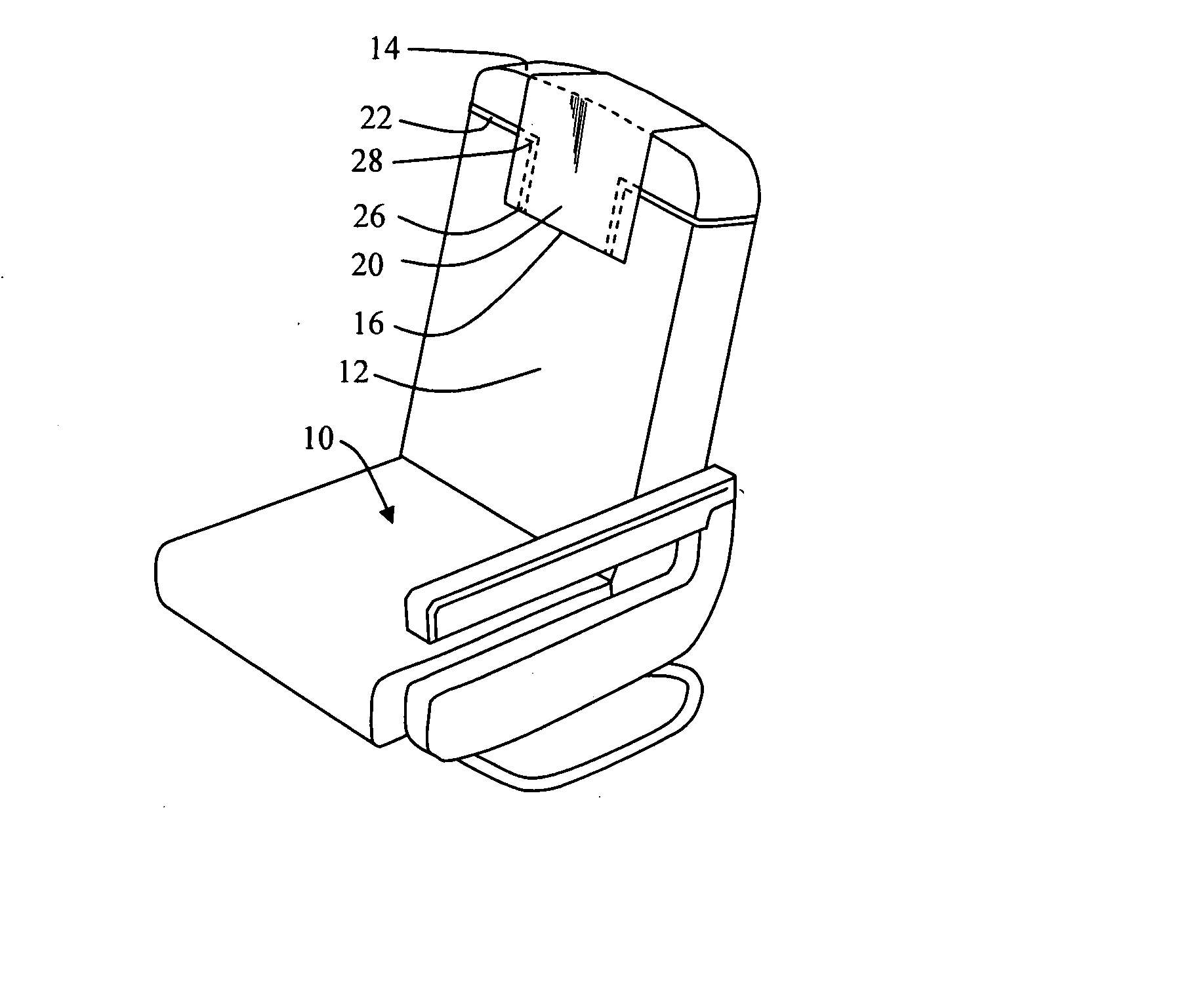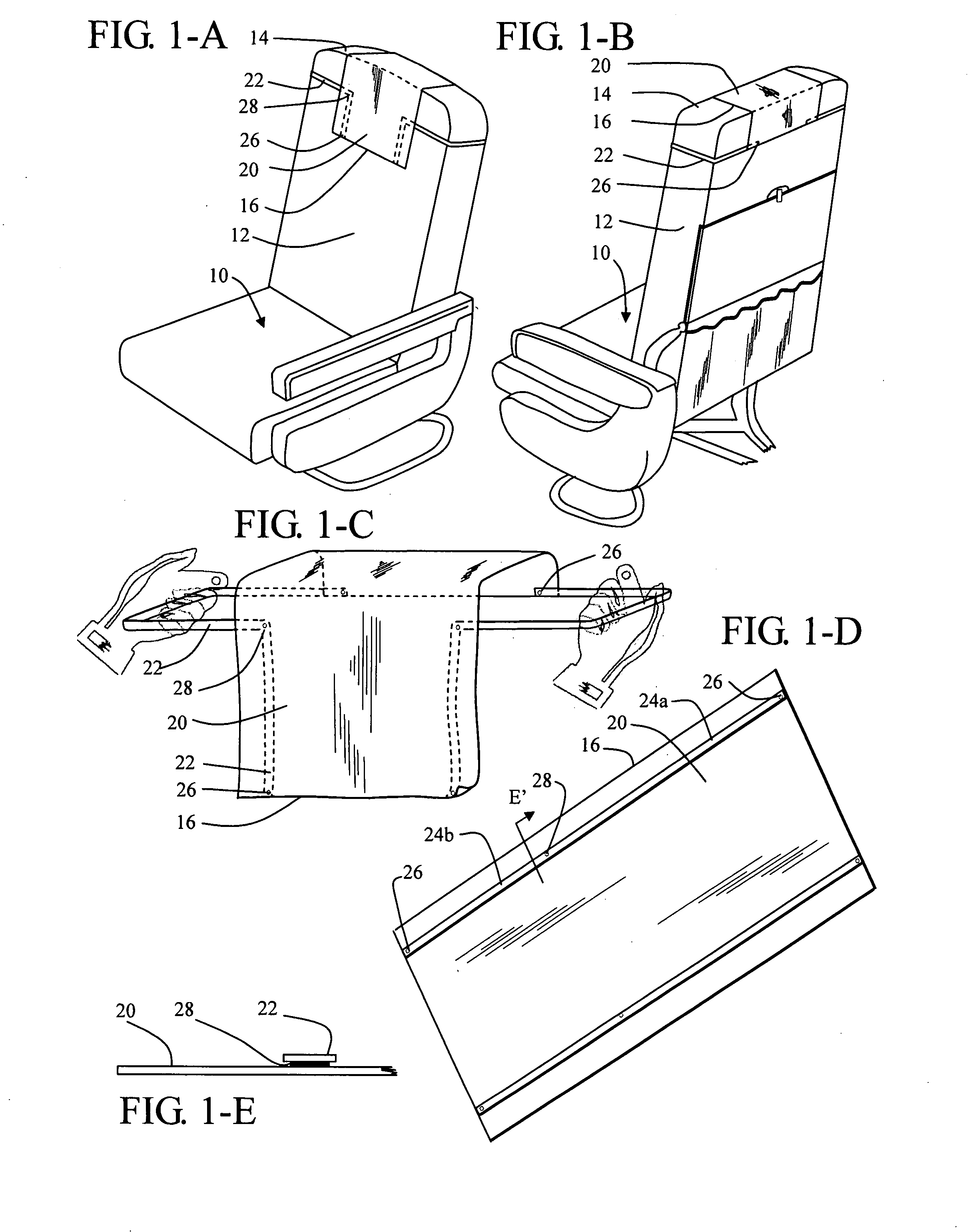Such continuous contact with the headrest results in it quickly becoming soiled, creating a potentially unsanitary surface, which may act as a conduit to transfer contaminants to subsequent occupants.
High traffic surfaces harbor microorganisms that can contaminate a multitude of people.
Some seats may even go years before being properly cleaned.
In many cases, the cleaning process might not sufficiently sanitize the headrest.
If headrest surfaces are not consistently cleaned after each occupant, the seats can potentially
expose a multitude of future occupants to serious health hazards which could later be transferred and spread across entire communities.
Unfortunately, the sporadic and inconsistent manner in which such covers are presently used does little in preventing the
contamination of public seats and consequently that of their occupants.
Many transportation carriers would not be able to absorb the time and financial burden required in complying with such a legal requirement, and those industries that did, would likely pass the incremental cost directly on to the customers.
One reason airlines do not provide protective covers to passengers is the fact that most, if not all presently available headrest covers, are too costly to provide.
They require extensive handling and are considered invasive to the seat, often requiring attachment elements to be previously and permanently embedded onto the seats.
The need for a special tool to attach the cover to the headrest, and the requirement of having to permanently embed the receiving engagement element onto a seat, turns the method of attachment into an inefficient, inconvenient, and expensive alternative.
Another unpopular method to engage replaceable covers to a seat headrest is with the use of
adhesive strips.
An inherent problem with such methods of attachment is the build-up of
adhesive residue on the headrest, which creates a sanitary
hazard in itself.
Separate from the
hygiene concern, certain materials used in the construction of seats do not lend to adequately hold
adhesive strips.
Any method requiring repetitive application of adhesive substances on the seat's surface, especially to the area where occupants usually rests their heads, is not one that can be widely embraced by any industry or health agencies.
For the above stated reasons, the use of such hook-and-loop and adhesive engagement devices and reusable covers is dramatically declining and even discontinued, as the handling process for the covers and specific requirement of embedding engagement elements onto the seat results in it being a costly alternative.
In addition, the engagement elements permanently embedded onto the seats can degrade the seat's appearance and become cause for
hygiene concern themselves.
These types of materials and reusable fastening elements are expensive to purchase and their loss by unauthorized removal and mishandling adds to the
operating cost.
The laundering of such covers is an expensive operation, requiring additional handling for packaging and transporting it to and from the
processing locations.
Unless a fresh cover is provided for each individual passenger, the frequency in which covers are currently utilized does little to fulfill the object of providing
hygiene protection for passengers.
Even when carriers try to provide and replace covers after each passenger, significant waste results when
service personnel are not able to distinguish between used covers and those that have not yet been utilized.
Thus it can be concluded, that the process of using any of the present headrest covers available is costly and time prohibitive for most carriers, especially when they have to be replaced with each leg of travel.
In summary, a number of issues presently face carriers when using any of the currently available headrest covers and it becomes apparent that these issues are major deterrents to the consistent use of headrest covers.
These issues include: the high cost to purchase; the cost to incorporate required engagement elements onto existing and new seats; the labor cost required to implement a one cover per passenger cycle; the cost of replacing all covers after each individual use; the cost of discarding fresh covers, not being able to distinguish the used from the new covers; the cost of shipping, laundering, storing and handling of reusable covers; the cost associated with potential delays to flight schedules contribute an unnecessary burden on industries already in distress.
The above harmful
impact to the use frequency for headrest covers obliterates a cover's ultimate function; to protect individuals and communities from potential
contamination.
Once again in summary, all reusable and disposable replaceable headrest covers previously developed, suffer from a number of critical disadvantages that hinder the consistent use of said covers.
If the travel
community and general public have not yet publicly raised concerns, it is mainly because they are uninformed about some facts.
(a) Public seats seldom are properly cleaned and when they are, it is often only after months, if not years of
continuous use.
(c) Every time individuals occupy a public seat without being adequately protected they can potentially become contaminated with a variety of
skin conditions, parasitic caused illnesses and other contagious diseases.
Rubbing ones' eyes,
nose, or mouth after touching contaminated surfaces increases the possibility of becoming ill and of further spreading of germs.
Becoming aware of these and other more specific consequences without the benefit of the present invention could cause public
panic, disrupt communities, and even negatively
impact the economy of a given sector.
Getting ill while aboard an
airplane can be a serious matter.
High traffic surfaces harbor microorganisms that can contaminate a multitude of people.
 Login to View More
Login to View More  Login to View More
Login to View More 


